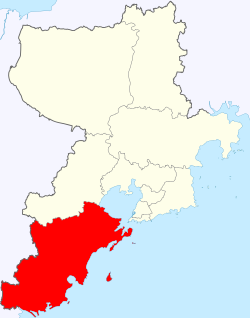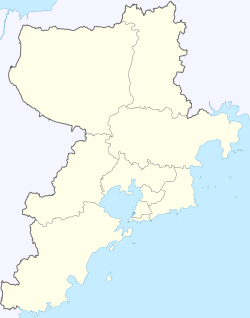Huangdao District / West Coast New Area
黄岛区 / 西海岸新区 | |
|---|---|
| Huangdao District / West Coast New Area | |
 | |
 Huangdao / West Coast New Area in Qingdao | |
| Coordinates: 35°52′22″N 120°02′46″E / 35.8727°N 120.0462°E | |
| Country | China |
| Province | Shandong |
| Sub-provincial city | Qingdao |
| Township-level divisions | 12 subdistricts 10 towns |
| District seat | Yinzhu Subdistrict (隐珠街道) |
| Area | |
• Total | 2,220.10 km2 (857.19 sq mi) |
| Elevation | 25 m (83 ft) |
| Population (2019) | |
• Total | 1,608,200 |
| • Density | 720/km2 (1,900/sq mi) |
| Time zone | UTC+08:00 (China Standard) |
| Postal code | 266400, 266500 |
| Area code | 0532 |
| Website | HuangDao.gov.cn |
| Huangdao District | |||||||
|---|---|---|---|---|---|---|---|
| Traditional Chinese | 黃島區 | ||||||
| Simplified Chinese | 黄岛区 | ||||||
| Literal meaning | Yellow Island District | ||||||
| |||||||
| West Coast New Area | |||||||
| Traditional Chinese | 西海岸新區 | ||||||
| Simplified Chinese | 西海岸新区 | ||||||
| |||||||
Huangdao District (Chinese: 黄岛区; lit. 'Yellow Island District') and West Coast New Area[1] (Chinese: 西海岸新区), is a district and a state-level new area of Qingdao, Shandong, China, located south-west and west of the main urban area of the city on the western shore of Jiaozhou Bay. It was identical to Qingdao Economic and Technological Development Zone (QETDZ, simplified Chinese: 青岛经济技术开发区; traditional Chinese: 青島經濟技術開發區; pinyin: Qīngdǎo Jīngjì Jìshù Kāifā Qū), which was launched in 1985 after the zone was merged with Huangdao District and set up the Free Trade Zone in 1992. In December 2012, Jiaonan, a county-level city in Qingdao was merged into Huangdao District.[2]
The pillar industries engaged in the zone include electronics, household electric appliances, building materials, petrochemicals, machinery and pharmaceutical drugs.[3][4] It is connected via Qingdao Jiaozhou Bay Bridge.
In mid 2018, the Ministry of Civil Affairs approved the consolidation of Huangdao District Government and West Coast New Area Government into a single governing body, which became the fourth administrative state-level new areas after Pudong of Shanghai; Binhai of Tianjin; and Nansha of Guangzhou. The population was 1.71 million in 2014.
- ^ "QINGDAO WEST COAST NEW AREA". Archived from the original on 2024-05-02. Retrieved 2024-05-02.
- ^ "青岛部分行政区划调整-中国青年报" [Some Administrative Regions in Qingdao-China Youth Daily]. zqb.cyol.com. 2012-12-03. Retrieved 2023-10-13.
- ^ Introduction to Qingdao Economic & Technical Development Zone Archived 2012-08-05 at archive.today Qingdao Government
- ^ Qingdao Economic and Technological Development Zone chinadaily.com.cn 2006-04-19

